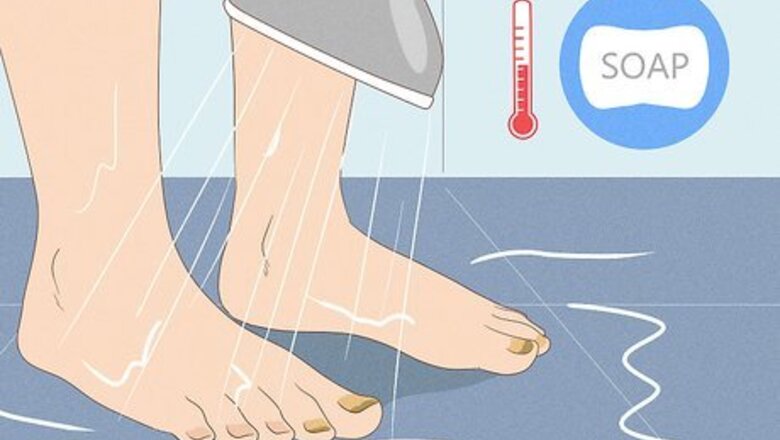
views
- Treat fungal infections with an over-the-counter antifungal cream or ointment to stop your toenails from getting worse.
- See a doctor if home remedies aren't effective after a month.
- Scrub your nails with baking soda or toothpaste to get rid of stains.
- Keep your feet clean and dry to prevent infection and keep your nails looking their best.
Treating Fungal Infection
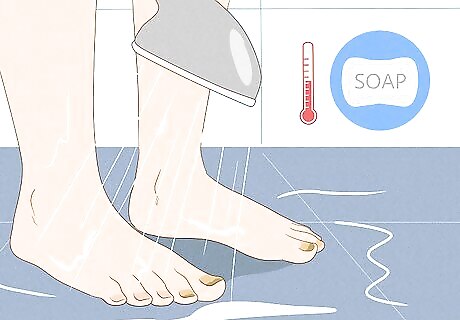
Wash your feet and toes in soap and warm water. Do this at least twice a day while you have the infection, as well as every time you take off your shoes. Dry your feet completely, then cover them with clean moisture-wicking socks. Always wash and dry your feet before you apply any kind of treatment. Sometimes, a mild infection will just go away on its own if you focus on keeping your feet clean and dry at all times.
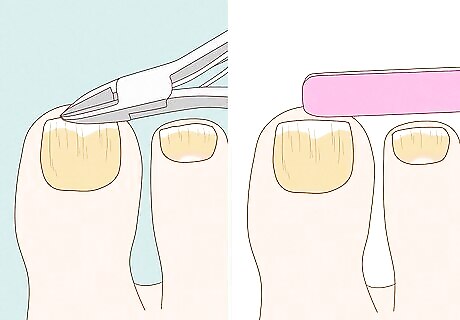
Trim your nails straight across the top and file the edges. Use toenail clippers to trim your nails, then file them with an emery board or toenail file. You might also buff lightly over the surface of infected nails to make it easier for the nail to absorb topical treatments. Disinfect your toenail clippers and file with rubbing alcohol after each use (just throw away an emery board). Don't borrow a toenail clipper or file from anyone else or let anyone else use yours—you don't want to spread the fungus.

Apply an over-the-counter (OTC) antifungal cream or ointment. These products typically work best if you have a mild infection and your nails aren't brittle or chipped. Usually, you'll wash your feet and then apply the product twice a day for several weeks, but follow the specific instructions on the product you buy. There's also some evidence that Vick's VapoRub can treat nail fungus if you rub it over the affected nails and surrounding skin. Since it's often cheaper than OTC antifungals, it's certainly worth a try. Fungal infections can spread, so you should treat the skin around your nails and your feet as well. If your nail infection keeps coming back, try treatments for athlete's foot.

Try a natural treatment to combat the fungal infection. If you ask around, you'll likely find that everyone you know has a natural treatment they swear by to get rid of yellow toenails. The problem is that these treatments don't tend to work for most people. That being said, they're totally safe to try! Here are some good options that work for some people: Baking soda: Mix baking soda and water to form a paste, then scrub that into your nails with a toothbrush for 5-10 minutes. You can also soak your feet in equal parts baking soda and water for 15-20 minutes. Tea tree oil: Use a cotton ball to dab the oil on and around your toenails. Do this at least twice a day. Olive leaf extract: Use a cotton ball to dab the extract on and around your toenails. Do this at least twice a day. Coconut oil: Melt a small amount of coconut oil in the microwave. Check the temperature to make sure it's not too hot, then dip a cotton ball in the liquid oil and massage it into your toes and toenails.
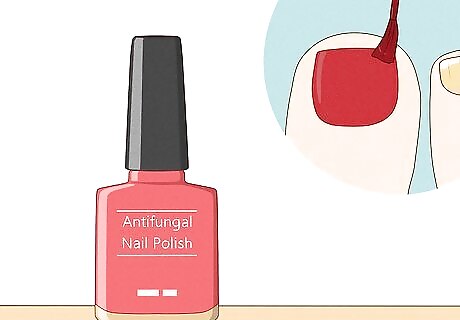
Hide the yellow behind antifungal nail polish. Before you paint your nails, make sure your toenails and feet are clean and your toenails are freshly trimmed and filed. Start with a clear base coat, then apply a colored polish. You typically have to reapply the polish at least once a week. Antifungal nail polish can take up to a year to treat the underlying infection, so it's not exactly the quickest remedy. But it will cover up your yellow toenails in the meantime.

See a doctor if your nails don't improve after a month. If topical treatments aren't doing the trick, your doctor can prescribe an oral medication. Typically, you'll take this medication once a day for up to 3 months to clear the infection. While oral medications tend to work better than topical ointments or creams, they still don't have a super high success rate, so there are no guarantees this will work. Even after the infection is gone, it could still take up to a year for the yellow nails to completely disappear.
Cleaning Stains
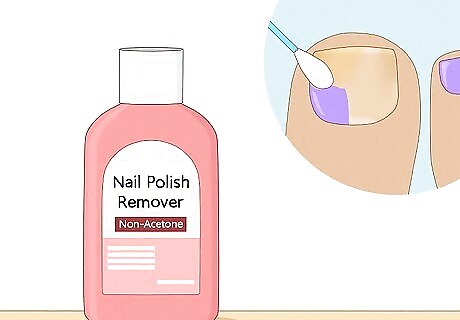
Remove polish with non-acetone nail polish remover. Soak a cotton swab in nail polish remover and carefully remove all the polish from each nail. Then, wash your feet with soap and warm water and follow up with a light moisturizer, since nail polish remover can dry out the skin around your nails. Acetone nail polish remover can make stained nails look even worse. It can also leave your nails with a pale yellow tint on its own.
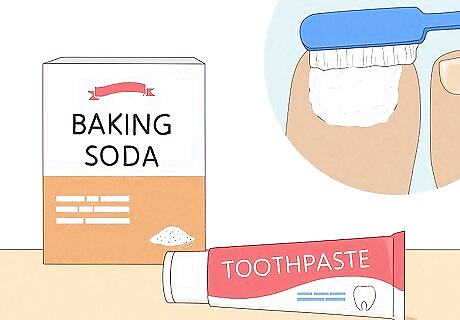
Scrub your toenails with baking soda or toothpaste. Mix baking soda and warm water to form a paste (or just use toothpaste) and scrub your toenails gently with a toothbrush for about 5 minutes to help lighten or completely remove the stain. You can also just leave the paste on your toenails to absorb for a few minutes before you scrub. Sometimes you'll see people recommend acids, such as lemon juice, to remove yellow stains. You can try them, but they don't tend to work as well.
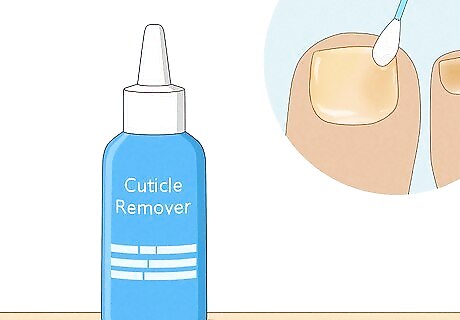
Use cuticle remover if your toenails are severely stained. Dab the cuticle remover directly on the stained portion of your toenails. Wipe off any excess, especially if it gets on your skin. Leave it for 15-20 minutes, then wash your toenails thoroughly with soap and warm water. Since your nails are made of keratin, the same thing as cuticles, the cuticle remover will remove the stained portion of your nail. Cuticle remover can damage your toenails, so only use it if your toenails are severely stained and you're not getting great results from baking soda or toothpaste. Don't use cuticle remover repeatedly—it will thin your toenails a little each time you use it.
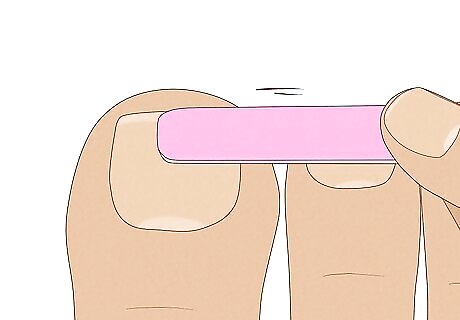
Buff your nail lightly to remove any remaining stains. Use an emery board to lightly scrape away the stained portion of your nail. Don't buff too hard—you don't want to thin your nail too much or it will break easily. Leave this as a last resort after you've tried other options. It won't help you a lot to remove the stains if you end up damaging your nail in the process. If you do buff your nails, follow up with a clear strengthening nail polish to help repair the damage.
Prevention
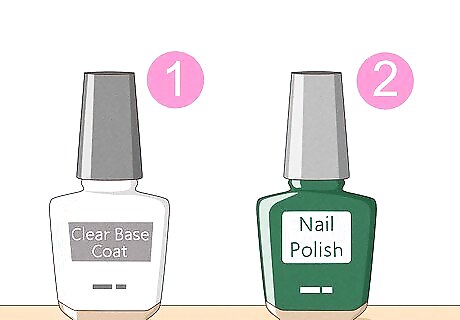
Apply a clear base coat under dark nail polish. A clear base coat keeps the dyes in the dark nail polish from staining your nails, so you won't have to worry about that problem in the future. Make sure the base coat is completely dry before you add the color over top. Try to give your toenails a break every 4-6 weeks and go without polish for a week or two. It'll give your nails a chance to breathe and repair themselves so they'll look their healthiest.
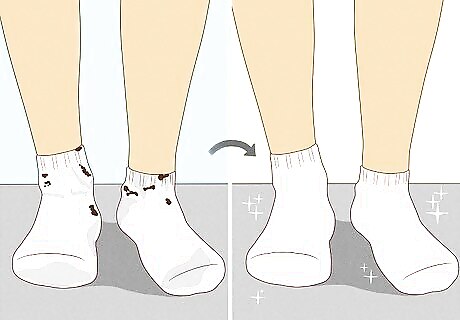
Change out of wet, dirty socks as quickly as possible. Fungus thrives in humid environments with a high pH, which makes sweaty socks the perfect place to start a colony. If nail fungus is a recurring problem for you, keep a pair of clean socks with you in a plastic bag. When your socks get sweaty, swap them out and put the dirty ones in the plastic bag. If possible, wash your feet with soap and warm water before you put on the fresh socks. At a minimum, make sure your feet are completely dry before you put on clean socks.

Wash your feet with soap and warm water after taking off your shoes. Use a clean washcloth to wash your feet. Then, thoroughly dry your feet with a clean towel. Wear flip-flops or clean, dry socks at all times. If you have an active fungal infection, don't reuse washcloths or towels that you used to wash and dry your feet.

Wear sandals, open-toed shoes, or breathable sneakers. These types of shoes keep air flowing around your toes and don't trap moisture, so your toes will stay drier. If you have to wear different shoes for work, take them off periodically if you can, or bring a change of socks or hosiery. If possible, alternate shoes so they have 24 hours to dry out before you wear them again.
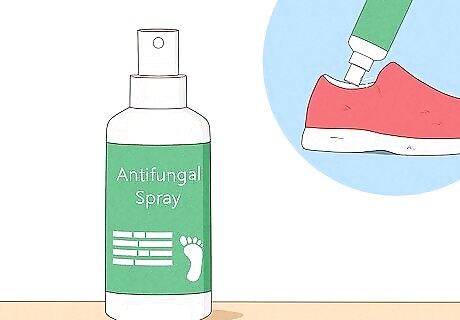
Spray old shoes with an antifungal and disinfectant. If you previously had a nail infection, it's usually best to just throw away any shoes you wore before you started treating that infection. But if you don't want to get rid of a good pair of shoes (or can't afford to replace them), spraying them down is a good option to prevent reinfection. Keep in mind that these sprays don't actually treat fungal infections, so wait until your infection has cleared before you spray your shoes.
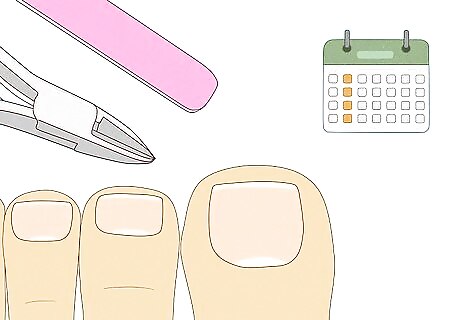
Trim and file your toenails once a week. Keep your toenails short and neat to help prevent them from getting re-infected. This is especially important if you're still using an antifungal cream or ointment on your nails. Disinfect your clippers and file with rubbing alcohol both before and after using them.
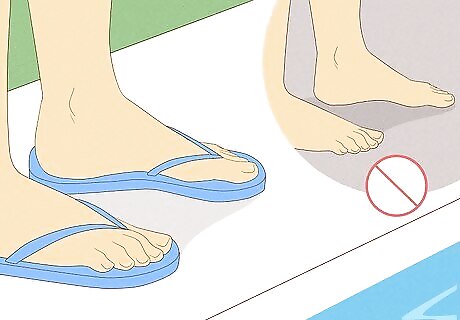
Avoid going barefoot in damp areas. Locker rooms, showers, and pool areas are prime places to pick up a fungal infection. Flip flops or shower shoes will protect your feet and toenails from potential infection.



















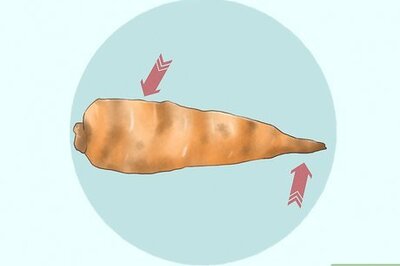
Comments
0 comment